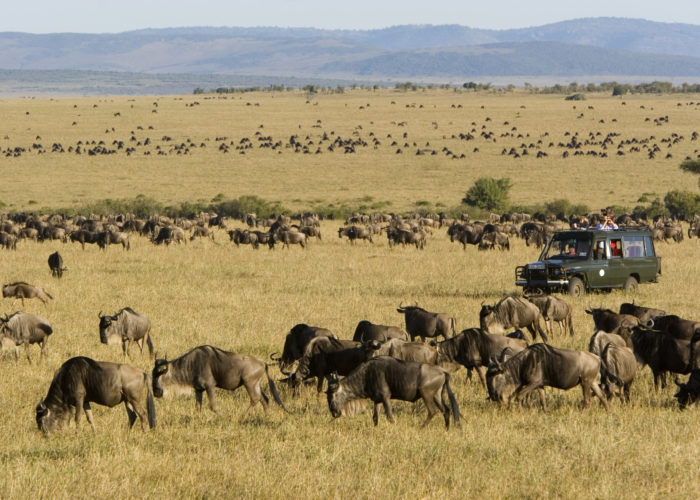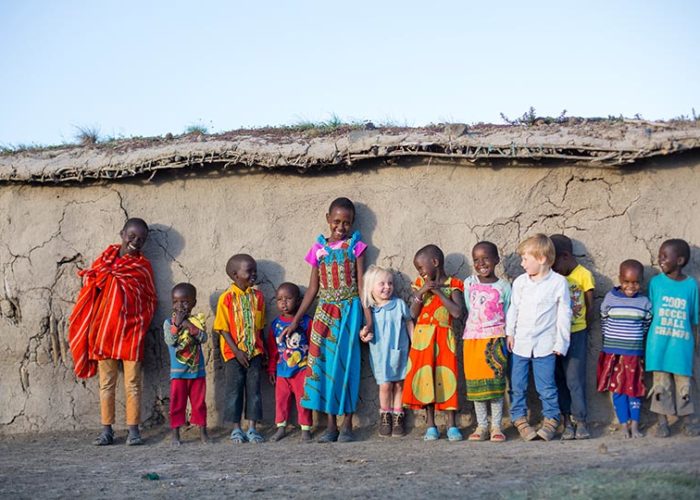Kenya is the original African safari destination and still one of the best. Around 8 percent of the country’s land is protected, and it is home to nearly 400 species of mammals and more than 1,000 species of birds. Part of East Africa, the country is known for scenic landscapes, vast wildlife preserves and cultural tribes. Its landscapes range from sun-bleached savannahs to jagged mountain peaks. The western provinces are forested and marked by rivers and lakes with a small portion in the north being desert and semidesert.
The country has at least 40 different ethnic African groups (including the Kikuyu, Luhya, Kalenjin tribes, Luo, Kamba, Kisii, Meru & Embu, Mijikenda, Swahili, Turkana and Masai) who speak a variety of mother tongues. Waves of migration over the centuries from the north and south of the continent have led to Kenya becoming one of the most diverse African countries culturally and linguistically.
CLIMATE
Kenya lies on the Equator, therefore our dry and wet seasons have relatively stable and pleasant temperatures, and allow year round safaris and game viewing. Many parts of the country are at an altitude of 2000m / 6000ft. These highlands, e.g. Laikipia, Mathews Range and the Masai Mara experience a cool and temperate climate. Lower regions at an altitude if 1200m / 3800ft, such as the semi-desert areas of Samburu/Shaba, Meru and the coastal strip, can reach a dry and comfortable 35° C during the day.
SEASONS
January – March
The hottest and driest time of year, and a popular time for those in the northern hemisphere to escape the cold. One of the best game viewing times of year.
April – June
The “long” rains arrive with the south east monsoon winds. A wonderful time to be on safari – clear spectacular skies, fewer tourists, and the baby boom with many species giving birth in time for the lush vegetation. Birds are in their mating plumage and wild flowers are in abundant bloom.
July – September
The coolest time of year. Many coast properties close from June to August inclusive. However this is the prime time to witness the wildebeest migration in the Masai Mara.
October – December
Ideal time of year to come on safari, with the wildebeest migration usually extending into November. November can experience the “short” rains brought by the North East monsoon, usually short showers in the early mornings and evenings, with clear days. Check for green and mid-season rates which can give a saving of up to 35% per room per night. High season rates are often governed by the peak holiday weeks of northern hemisphere travellers, rather than by best safari times. Visiting during green & mid-season gives guests the opportunity to find and observe game with maximum privacy.
CULTURE
Kenya has a culture born of countless sources. From the prehistoric records of early man to the present day, Kenya has been a land of unending change, contrasts, and diversity; it is home to 52 tribes – some still staunchly traditional, others live a very modern lifestyle as the influences of the Western World increase. Many prime gameviewing areas are in pastoralist lands, and the colourful local tribes are our hosts. A safari with Adventure To Africa gives you the opportunity to interact with these tribes at a personal level.
See our ITINERARY SUGGESTIONS under the Kenya tab.
Map of National Parks and Conservancies

The Masai Mara is arguably the most famous Big 5 reserve in the world, and therefore the setting for dozens of BBC and National Geographic wildlife documentaries. As well as its high concentration of lion, leopard and cheetah, the Mara is the site of the Great Migration river crossings, when approximately 1.5 million wildebeest must cross the crocodile-filled waters as part of their endless journey around the Mara and the adjacent Serengeti in Tanzania.
The Maasai people have lived here for hundreds of years and make the best guides and custodians of the land. Surrounding the Masai Mara National Reserve are several community-owned conservancies. Together, they make up the Greater Masai Mara area that also includes the Masai Mara North Conservancy. Unusually for a safari area, you might also see the Masai’s lifestock grazing in the Conservancies. You will not find lifestock in the Masai Mara National Reserve tough. The advantage of being in the Conservancy is that only vehicles from lodges in the conservancy are allowed, hence less vehicles in conservancies.
When to visit:
The Masai Mara has permanent water sources with excellent resident wildlife year round.
January to May:
There are fewer tourists in the Mara, but still plenty of possible wildlife sightings (like black rhino, elephant and Maasai giraffe). Some wildebeest remain in the Mara, where they are preyed on by the area’s big cats. From November until April, the migratory birds swell with the Mara’s recorded bird count close to 500.
There are two rainy seasons: March to May (long rains) and November to December (short rains). The peak of the wet weather is between March and May.
The temperature doesn’t change much throughout the year. The high ranges from 25°C to 28°C/77°F to 82°F during the day with nighttime lows ranging from 11°C to 3°C/52°F to 56°F.
July to November:
The wildebeest herds arrive in the Mara from July and depart in October or November. Their movements differ slightly year to year, depending on the rains and the availability of pasture.
It’s possible to see these massive wildebeest herds from all of our camps in the Mara. From some camps, guests can watch the herds without even leaving camp. There’s a major Talek River crossing point just 150 metres from our dining deck at Rekero and Topi House is right on the migration route.
The dry season is from June to October. The temperature doesn’t change much throughout the year. The high ranges from 25°C to 28°C/77°F to 82°F during the day with evening lows ranging from 11°C to 3°C/52°F to 56°F.
For the Wildebeast Migration: From July to November each year, the great wildebeest herds arrive from Tanzania. To reach the grasslands of the Mara, they must risk their lives crossing the Mara River, where famished crocodiles wait in the swollen waters. After nervously milling about on the banks, it takes just one wildebeest to leap in, and then the herd follows en masse in a cacophony of grunts, thundering hooves and splashing water. The river crossings are iconic — the subject of many nature documentaries — and attract huge numbers of tourists each year.
Wildlife: The Mara is known as one of the best places in Africa for game viewing, with more than 90 animal species and nearly 500 bird species in the ecosystem. It’s excellent for big cats. The Mara has the highest lion density in Kenya, and leopard and cheetah are common sights, too. There are spotted hyena, black-backed and side-striped jackal, serval, the occasional caracal and even African wild dog. Plains game can be seen all year round. There are always Thomson’s and Grant’s gazelle, zebra, oribi, Coke’s hartebeest, eland and some roan antelopes.
Supporting the second highest density of wildlife in Kenya, the vast 9,500km2 Laikipia plateau stretches from the slopes of Mount Kenya in the south east to the edge of the Great Rift Valley in the west.
Ranging from dry savannah and open woodlands to dramatic canyons and low forested valleys, the Laikipia plateau is made up of a collection of extensive community owned ranches, private farms and wildlife conservancies working in unison on some of Kenya’s most effective conservation projects.
One of Kenya’s most exciting wilderness areas, Laikipia showcases the positive impact of community engagement on tourism and conservation as well as the benefit to local communities. From the ground-breaking partnership between Maasai and Samburu communities, private investors and conservation organisations on the 40,000 acre Ol Lentille Conservancy balancing tourism and economic development with ambitious conservation and community development programs to the Ol Pejeta Conservancy wildlife protection units at the forefront of protecting numerous species from extinction throughout Laikipia and the Grevy’s Zebra conservation work on the Lewa Wildlife Conservancy.
We are strong believers that each visitor to Kenya should experience the remarkable work being carried out in the Laikipia region, not only to enjoy the beauty and wildlife but to ensure that each visitor knows that everyone can make a difference and ensure the conservation of the wilderness, wildlife and communities that call it home.
North of Mount Kenya and Laikipia, the Samburu ecosystem is comprised of Samburu National Reserve, Shaba National Reserve, Buffalo Springs Reserve, Kalama Conservancy, West Gate Community Area and Nakupurat-Gotu Conservancy.
A rugged and semi-desert savannah intersected by the Ewaso Nyiro River, the area has an abundance of wildlife including Nile crocodile, cheetah, leopard, lion, elephant, buffalo and hippo as well the rare species of long necked gerenuk, Grevy’s zebra, reticulated giraffe and Beisa oryx.
The ecosystem’s remote location provides an untouched and unspoilt wilderness of open savannah, volcanic rocks, sacred mountains and the Ewaso Nyiro River lined with an oasis of vegetation attracting over 350 species of bird including vulture, kingfisher, guinea fowl and Somali ostrich.
Situated in the foothills of snow-capped Mount Kenya on central Kenya’s Laikipia Plateau is Ol Pejeta Conservancy, a trailblazer in conservation, most famous for protecting the world’s last two northern white rhinos.
Across the 36,400-hectare conservancy, you might spot lion prowling the plains, giraffe and elephant munching on whistling thorn trees, cheetah scanning for prey or even elusive wild dog and leopard. It’s one of the largest black rhino sanctuaries in East Africa. Unlike in many protected areas, cattle farming has been built into Ol Pejeta’s conservation plan, benefitting the land and wildlife through strategic grazing, and the people through employment.
Ol Pejeta offers a huge range of activities and is ideal for active types, families or honeymooners, making it one of the best places to visit in Kenya. Start the day with a jog with the rangers or a walk across the savannah to spot birds, learn about tracking, identify plants and maybe even watch a black rhino browsing from a safe distance. As well as game drives, visitors can go cycling or horse riding through the reserve, meet the anti-poaching dogs or track lion with the conservancy’s researchers. The fees for these activities help fund conservation initiatives.
Ol Pejeta Conservancy Wildlife
Ol Pejeta Conservancy is home to the Big 5 (lion, leopard, elephant, buffalo and rhino – black, southern white, and northern white), as well as cheetah and wild dog. There are endangered Grévy’s zebra and Jackson’s hartebeest in the 283-hectare Endangered Species Enclosure, which is also where the last northern white rhinos live. Birders can look out for around 300 bird species. Unusually for a safari area, you might also see the conservancy’s Boran cattle herds. Learning how cattle grazing fits into Ol Pejeta’s conservation plan is fascinating. Visit one of the protective night-time bomas (animal enclosures) with your guide to learn more.

Founded in 1899 as a rail depot for the Uganda Railway, Nairobi has grown to become one of the most prominent, thriving capital cities on the continent.
The world’s only capital city with a national park, Nairobi is a vibrant combination of modern life, African culture and nature. Skyscrapers, banks, malls, international hotels and businesses are prominent throughout Nairobi. Close to Nairobi National Park, the suburbs of Langata and Karen have maintained the traditional Nairobi charm with tall mature trees and vast gardens.
The original safari capital of Africa, Nairobi offers world class accommodation from intimate boutique hotels in tranquil gardens to 5 star luxury international hotel chains. Whether you are looking to explore the original home of Karen Blixen, feed giraffe by hand, adopt an orphaned baby elephant, taste ‘Nyama Choma’ or pick up artisan pieces at a local market, Nairobi never sleeps and there’s an adventure opportunity around every corner.
 English
English Deutsch
Deutsch
















